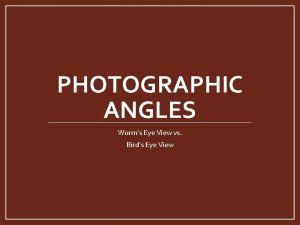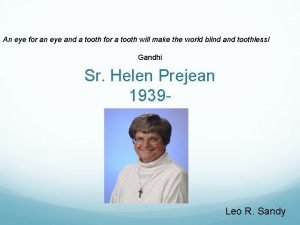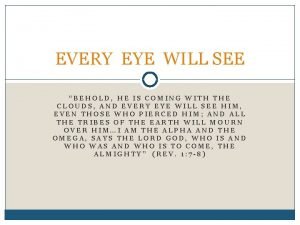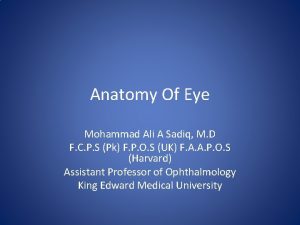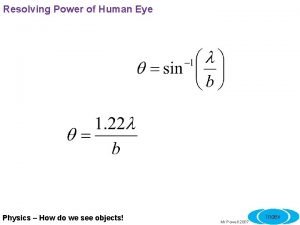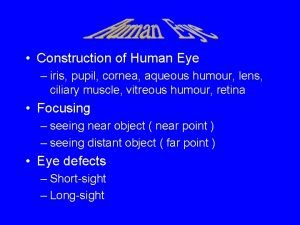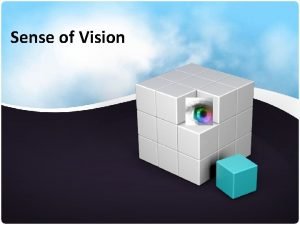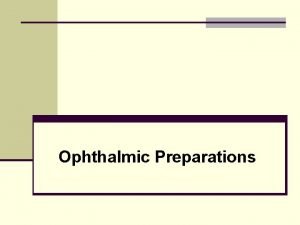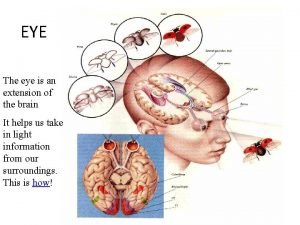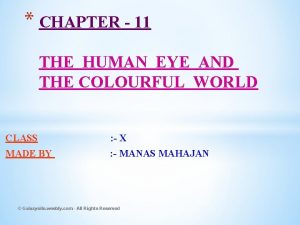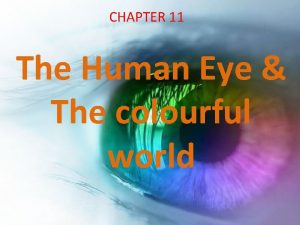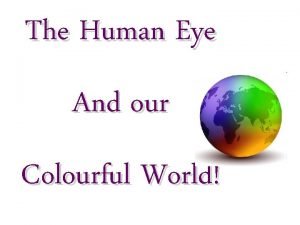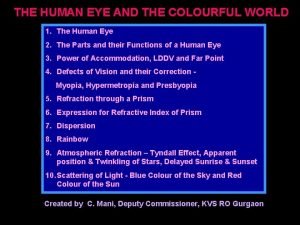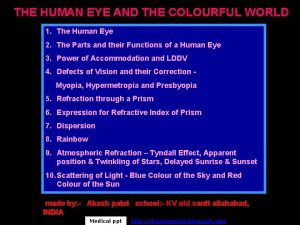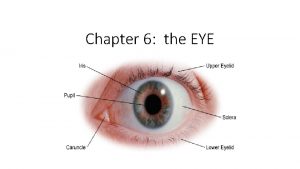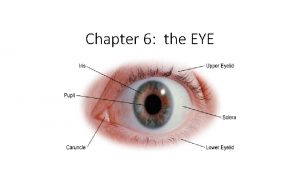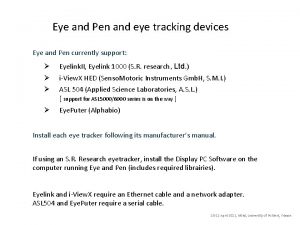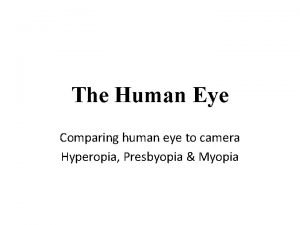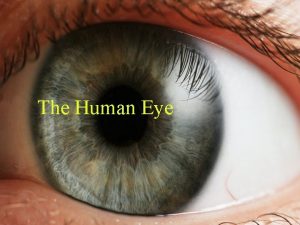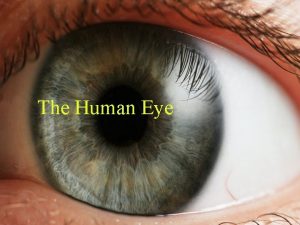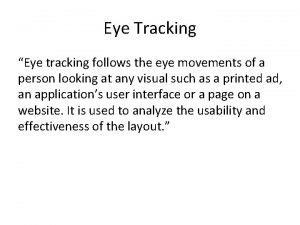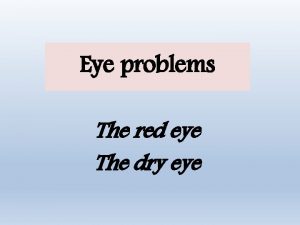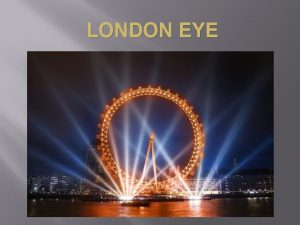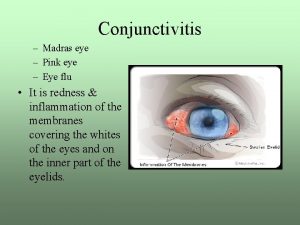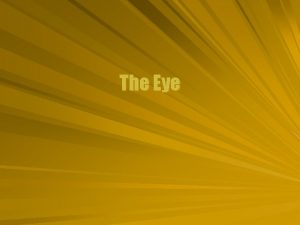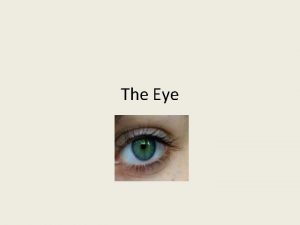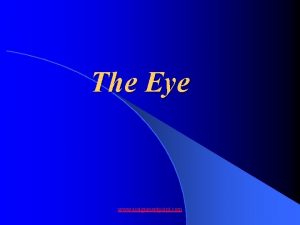CHAPTER 11 THE HUMAN EYE AND THE COLOURFUL























- Slides: 23

CHAPTER - 11 THE HUMAN EYE AND THE COLOURFUL WORLD Class Subject Name of Teacher School : - X : - Science : - Mr. V. K. Pathak (PGT Phy) : - KV RRL Jorhat, Assam

THE HUMAN EYE

1 a) The human eye : The human eye is the sense organ which helps us to see the colourful world around us. The human eye is like a camera. Its lens system forms an image on a light sensitive screen called retina. The eye ball is almost spherical in shape with a diameter of about 2. 3 cm. Light enters the eye through a transparent membrane called cornea. Behind the cornea is a muscular diaphragm called iris which has an opening called pupil. The pupil controls the amount of light entering the eye. The eye lens helps to focus the image of objects on the retina. The ciliary muscles helps to change the curvature of the lens and to change its focal length. b) Working of the eye : The eye lens forms a real inverted image of the object on the retina. The light sensitive cells in the retina then produce electrical signals which are carried by the optic nerves to the brain. The brain processes the information and sends the message to the eye and then we see the object.

c) Power of accomodation of the eye : The ability of the eye lens to see both near and distant objects by adjusting its focal length is called the power of accommodation of the eye. The eye lens is composed of a fibrous jelly like material. Its curvature can be changed to some extent by the ciliary muscles. The change in the curvature of the eye lens can change its focal length. When the muscles are relaxed, the lens becomes thin and its focal length increases and when the muscles contract, the lens becomes thick and its focal length decreases. d) Near point : The minimum distance at which the eye can see objects clearly is called the near point or least distance of distinct vision. For a normal eye it is 25 cm. e) Far point : The farthest distance upto which the eye can see objects clearly is called the far point of the eye. For a normal eye it is between 25 cm and infinity.

2) Defects of vision and their correction : i) Myopia or near sightedness : - Myopic eye Correction using concave lens Myopia is a defect of vision in which a person can see nearby objects clearly but cannot see distant objects clearly because the image is formed in front of the retina. This may be due to: i) Increase in curvature of the eye lens ii) Increase in the length of the eye ball It can be corrected by using suitable concave lens.

ii) Hypermetropia or far sightedness : - Hypermetropic eye Correction using convex lens Hypermetropia is a defect of vision in which a person can see distant objects clearly but cannot see nearby objects clearly because the image is formed behind the retina. This may be due to: i) Decrease in curvature of eye lens ii) Decrease in the length of the eye ball It can be corrected by using a suitable convex lens.

iii) Presbyopia : Presbyopia is a defect of vision in old people in which they are not able to see nearby objects clearly due to the increase in the distance of near point. This is due to the weakening of the ciliary muscles and decrease in the flexibility of the eye lens. It can be corrected by using suitable convex lens. Sometimes they are not able to see both nearby and distant objects clearly. It can be corrected by using bifocal lenses consisting of both concave and convex lenses. The upper part is concave for correction of distant vision and the lower part is convex for correction of near vision.

4) Refraction of light through a glass prism : Glass prism Angle of deviation D Normal i r e Angle of emergence Incident ray Emergent ray Air Glass Air Refracted ray When a ray of light passes through a glass prism, it gets bent twice at the air- glass interface and glass- air interface. The emergent ray is deviated by an angle to the incident ray. This angle is called the angle of deviation.

5 a) Dispersion of white light by a glass prism : - R O Y G B I Beam of white light Spectrum V Glass prism When a beam of white light is passed through a glass prism, it is split up into a band of colours called spectrum. This is called dispersion of white light. The spectrum of white has the colours violet, indigo, blue, green, yellow, orange and red (VIBGYOR). The red light bends the least and the violet light bends the most.


b) Recombination of the spectrum of white light produces white light : White light R White light V R R V V Glass prisms When a beam of white light is passed through a glass prism, it is split up into its component colours. When these colours are allowed to fall on an inverted glass prism it recombines to produce white light.

c) Rainbow formation : Raindrop Sunlight Refraction and dispersion Internal reflection Refraction Red Violet Observer A rainbow is a natural spectrum appearing in the sky after a rain shower. It is caused by the dispersion of sunlight by water droplets present in the atmosphere. The water droplets act like small prisms. They refract and disperse the sunlight then reflect it internally and finally refract it again when it comes out of the rain drops. Due to the dispersion of sunlight and internal reflection by the water droplets we see the rainbow colours.


6) Atmospheric refraction : Star Apparent position Real position Increasing refractive index of atmosphere Eye Atmospheric refraction is due to the gradual change in the refractive index of the atmosphere. The refractive index of the atmosphere gradually increases towards the surface of the earth because the hot air above is less dense than the cool air below. So light gradually bends towards the normal. So the real position of a star is different from its apparent position.


i) Twinkling of stars : - The twinkling of stars is due to the atmospheric refraction of star light and due to the changing in the position of the stars and the movement of the layers of the atmosphere. So the light from the stars is sometimes brighter and sometimes fainter and it appears to twinkle. Planets are closer to the earth than stars. The light from stars are considered as point source of light and the light from planets are considered as extended source of light. So the light from the planets nullify the twinkling effect.


ii) Advance sunrise and delayed sunset : Apparent position Atmosphere Sunset Horizon Observer Sunrise Earth Real position The sun is visible to us about 2 minutes before sunrise and about two minutes after sunset due to atmospheric refraction. The apparent flattening of the sun’s disc at sunrise and at sunset is also due to atmospheric refraction.

7) Scattering of light : i) Tyndall effect : When a beam of light passes through a colloidal solution, the path of light becomes visible due to the scattering of light by the colloid particles. This is known as Tyndall effect. The earth’s atmosphere contains air molecules, water droplets, dust, smoke etc. When sunlight passes through the atmosphere the path of the light becomes visible due to the scattering of light by these particles. The colour of the scattered light depends upon the size of the scattering particles. Very fine particles scatter blue light. Larger particles scatter different colours of light.


ii) Why is the colour of the clear sky blue ? The fine particles in the atmosphere have size smaller than the wave length of visible light. They can scatter blue light which has a shorter wave length than red light which has a longer wave length. When sunlight passes through the atmosphere, the fine particles in the atmosphere scatter the blue colour more strongly than the red and so the sky appears blue. If the earth had no atmosphere there would not be any scattering of light and the sky would appear dark. The sky appears dark at very high altitudes.


iii) Colour of the sky at sunrise and sunset : Sun overhead Blue light scattered away Sun appears reddish Sun near horizon Observer Atmosphere Earth At sunrise and at sunset the sun is near the horizon and the light from the sun travels through the thicker layers of the atmosphere and longer distance through the atmosphere. Near the horizon most of the blue light and shorter wave lengths are scattered away by the particles of the air and the red light and longer wave lengths reaches our eyes. So the sun appears reddish at sunrise and sunset.
 Colourful sentence for class 1
Colourful sentence for class 1 Adjectives colourful semantics
Adjectives colourful semantics Superlative of colorful
Superlative of colorful Colourful semantics template
Colourful semantics template Bird's eye view angle
Bird's eye view angle Hammurabi mesopotamia
Hammurabi mesopotamia Eye for an eye code
Eye for an eye code Anemic eyes pictures vs normal
Anemic eyes pictures vs normal Hammurabi code an eye for an eye
Hammurabi code an eye for an eye An eye for an eye a tooth for a tooth sister act
An eye for an eye a tooth for a tooth sister act Explain the image
Explain the image An eye for an eye meaning
An eye for an eye meaning Behold he is coming
Behold he is coming Human needs and human development
Human needs and human development Chapter 8 human needs and human development
Chapter 8 human needs and human development Pars plicata
Pars plicata Aperture of human eye
Aperture of human eye Resolving power of human eye in mm
Resolving power of human eye in mm Construction of human eye
Construction of human eye Introduction of human eye
Introduction of human eye Introduction of human eye
Introduction of human eye Eye labeled
Eye labeled Human and non human nouns
Human and non human nouns Diversity and human needs and development
Diversity and human needs and development




